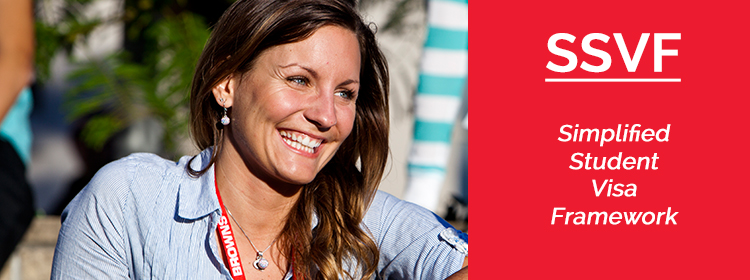Last Update: May 31st 2016
As you may be aware, the Australian Government is introducing the Simplified Student Visa Framework (SSVF) from July 1st 2016, which means massive changes for the Australian international education sector. Although some information is still yet to come from the Department of Immigration and Border Protection, this is all that we know so far.
Reasons for the Changes
With eight different visa subclasses, the assessment level framework and the streamlined visa processing arrangements, the current student visa framework is quite complex for students, agents, education providers and even for the Department. According to the Department the changes coming with the SSVF aim to make the student framework simpler for genuine students, deliver a more targeted approach to immigration integrity and create a level of playing field for all education providers.
Commencement Date for the SSVF
The Simplified Student Visa Framework (SSVF) will come to effect from the 1st July 2016. All student visa applications lodged and granted by the DIBP before that date will be subject to the current framework
Key Changes
The main changes under SSVF are:
Reduction of the number of student visa subclasses from eight to two
Within the current framework, there are eight student visa subclasses for each particular education sector and to make things more complicated, the amount of evidence required from the applicant to support their application not only depends on their nationality immigration risk, but also in the education sector of their studies.
Things could get more complex when the study plan for a student has more than one course across multiple sectors.
The great news is that under the SSVF, there will be only two subclasses: Student visa (subclass 500) and Student Guardian visa (subclass 590). This means only one visa subclass, regardless the education sector. This is where the term Simplified starts making sense for the framework.
All international students will be required to apply for their student visa online
Under SSVF, regardless of the students’ nationality, all applications for student visas must be completed online.
The introduction of a simplified single immigration risk framework for all international students
With the new changes, the amount of evidence required from the applicant to support their visa application will depend on a combination of the student’s nationality AND the immigration risk rating of the student’s education provider. This means that the requirements may be different depending on the education provider the student chooses.
The students will be able to easily identify what documents they will be required to provide with their visa application by selecting their intended education provider followed by country of citizenship into an online tool on the Department’s website.
In summary, students enrolled at an education provider with the lowest immigration risk outcomes will have lower evidentiary requirements, regardless of their nationality. Students enrolled at an education provider with the highest immigration risk outcomes will have access to reduced evidentiary requirements if they are from a country with the lowest immigration risk.
To sum up, there will be two categories that will define the evidentiary requirements: Streamlined and Regular

Applications processed under streamlined visa will require fewer amounts of evidence requirements than regular ones.
How will SSVF work for BROWNS prospective students
Based on the immigration risk outcomes of BROWNS, ALL NATIONALITIES under the table below will be processed under Streamlined visa processing arrangements. Countries not on the list have not yet been confirmed by the Department of Immigration and Border Protection for any Australian provider
| Country | Risk |
|---|---|
| Bangladesh | Streamlined |
| Brazil | Streamlined |
| Canada | Streamlined |
| Chile | Streamlined |
| China, Peoples Republic of | Streamlined |
| Colombia | Streamlined |
| France | Streamlined |
| Germany, Fed Republic of | Streamlined |
| HKSAR of the PRC | Streamlined |
| India | Streamlined |
| Indonesia | Streamlined |
| Italy | Streamlined |
| Japan | Streamlined |
| Korea, South | Streamlined |
| Malaysia | Streamlined |
| Mexico | Streamlined |
| Nepal | Streamlined |
| Nigeria | Streamlined |
| Norway | Streamlined |
| Pakistan | Streamlined |
| Philippines | Streamlined |
| Saudi Arabia | Streamlined |
| Singapore | Streamlined |
| Spain | Streamlined |
| Sri Lanka | Streamlined |
| Taiwan | Streamlined |
| Thailand | Streamlined |
| United Kingdom | Streamlined |
| United States of America | Streamlined |
| Vietnam | Streamlined |
| All Other Countries | Streamlined* |
*Awaiting confirmation from the Department of Immigration and Border Protection as of 31 May 2016
According to the information released so far, the following documents need to be provided by the students from the nationalities on the table, at the time of lodging the student visa application:
- Confirmation of Enrolment (CoE)
- Overseas Health Care Cover (OSHC)
All Student visa applicants must demonstrate to the education provider their condition of Genuine Temporary Entrant (GTE) and BROWNS reserves the right to request supporting documents to confirm this condition. Be aware that the Department of Immigration and Border Protection reserves the right to request additional documentation on a case-by-case basis. This documentation may include:
- Financial Documents
- Proof of your English Language ability
- Documents to prove that you will stay in Australia temporarily
- Medical report
For more information, please visit the DIBP website.
